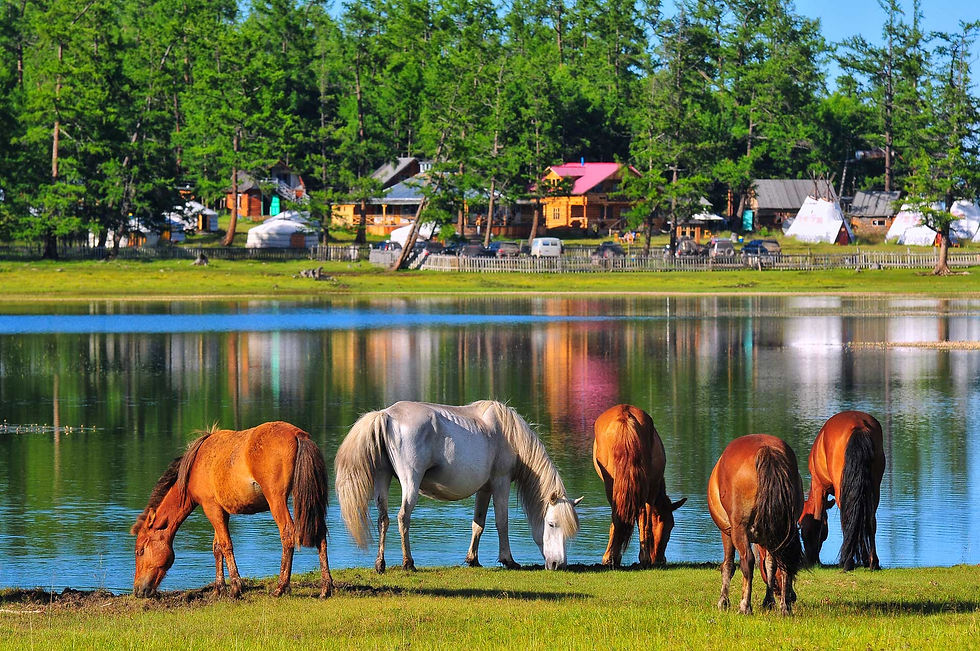The HU Band: Conquering the Global Stage with Mongolian Traditional Rock
- Enkhzaya Ganbold
- Mar 3
- 12 min read
Updated: Mar 12
Contents:
Who is the HU Band?
The Hu Band, also known as The HU, is a Mongolian rock band that gained international recognition for their unique fusion of traditional Mongolian music and contemporary rock elements. The band was formed in 2016 and consists of four members: Gala, Jaya, Enkush, and Temka. They draw inspiration from their Mongolian heritage and culture to create a distinctive sound that blends throat singing, traditional instruments such as the morin khuur (horsehead fiddle) and tovshuur (Mongolian guitar), with rock instrumentation.
The Hu Band gained global attention with the release of their debut album "The Gereg" in 2019, which featured their breakout hit "Wolf Totem." The band's music often incorporates powerful and evocative lyrics that celebrate Mongolian history, nature, and spirituality. Their songs explore themes of unity, strength, and the connection between humans and the natural world.
Through their energetic performances and visually striking music videos, the Hu Band has captivated audiences around the world. They have successfully introduced Mongolian traditional music to a global audience, breaking cultural boundaries and attracting fans from diverse backgrounds. The Hu Band's unique musical style, combined with their strong stage presence, has established them as a prominent force in the international rock music scene.
The Mongol and Hun empires
The Hun Empire:

The Hun Empire emerged in Central Asia during the 4th century CE under the leadership of Attila the Hun. Known for their fierce military prowess and nomadic lifestyle, the Huns embarked on a series of military campaigns, expanding their empire across vast territories. Their military tactics, which included horseback archery and swift cavalry attacks, struck fear into the hearts of their adversaries. The Hun Empire was a formidable force that disrupted existing power structures and exerted influence over both Eastern and Western Europe. Although the empire's reign was relatively short-lived, their impact on history is undeniable.
The Mongol Empire:

The Mongol Empire, founded by Genghis Khan in the 13th century, stands as one of the largest contiguous land empires in history. The Mongols were fierce warriors and brilliant strategists, known for their unmatched equestrian skills and their ability to adapt to different terrains and climates. Under Genghis Khan's leadership, the Mongols united various nomadic tribes, creating a formidable military force that swiftly conquered vast territories across Asia, Europe, and the Middle East.

The Mongols employed innovative military tactics, such as their mastery of cavalry warfare and their ability to wage successful siege warfare. However, they were also skilled administrators, implementing efficient governance systems and promoting cultural exchange throughout their vast empire. The Mongol Empire facilitated the exchange of goods, ideas, and technologies across the Eurasian continent, leading to increased trade and cultural diffusion.
Despite their fierce reputation, the Mongols were not solely focused on conquest. They established a Pax Mongolica, a period of relative peace and stability, which fostered trade, cultural exchanges, and the flourishing of arts and sciences.
Both the Hun and Mongol empires played crucial roles in shaping the course of history, leaving behind a complex legacy. While their military conquests and territorial expansions are noteworthy, their impact extends beyond warfare. These empires fostered cultural exchanges, influenced regional politics, and facilitated the exchange of knowledge, leaving an enduring mark on the civilizations that followed.
The Hu Band members:

Gala: Gala is one of the founding members of the Hu Band. He contributes to the band as a vocalist, using traditional Mongolian throat singing techniques. Gala's distinct vocal style and powerful stage presence are integral to the band's unique sound.
Jaya: Jaya is another vocalist in the Hu Band, known for his captivating throat singing abilities. His deep and resonant voice adds depth and texture to the band's music, enhancing their fusion of traditional Mongolian melodies and modern rock elements.
Enkush: Enkush is a member of the Hu Band who plays the morin khuur, also known as the horsehead fiddle. The morin khuur is a traditional Mongolian stringed instrument, and Enkush's skilled playing brings the melodic and cultural essence of Mongolia to the band's compositions.
Temka: Temka is a key member of the Hu Band, playing the tovshuur. The tovshuur is a two-stringed instrument resembling a guitar or lute, and it is commonly used in Mongolian folk music. Temka's mastery of the tovshuur adds a rich and authentic sound to the band's musical arrangements.
Touring members (2019-present):
Unumunkh "Ono" Maralkhuu: Ono contributes to the band as a percussionist, playing instruments such as tumur hhuur, and provides backing vocals during live performances.
Jambaldorj "Jamba" Ayush: Jamba is responsible for guitars and backing vocals while on tour with the Hu Band. His guitar skills contribute to the band's powerful and dynamic sound.
Nyamdavaa "Davaa" Byambaa: Davaa joined the band as a bassist and provides backing vocals during their live shows. His bass playing adds depth and groove to the band's music.
Odbayar "Odko" Gantumur: Odko takes on the role of drummer during the band's tours. His rhythmic contributions provide the driving force behind the band's energetic and captivating performances.
Former touring member (2019-2020):
Batkhuu Batbayar: Batkhuu served as the bassist and provided backing vocals during the early touring days of the Hu Band.
Instruments of the The HU Band
The Hu Band incorporates a blend of traditional Mongolian instruments and contemporary rock instrumentation to create their unique sound. Here are some of the instruments commonly used by the Hu Band:

1. Morin Khuur (Horsehead Fiddle): The morin khuur is a traditional Mongolian stringed instrument with two strings and a distinctive horsehead-shaped carving at the top of its neck. It is often played with a horsehair bow and produces a haunting and melodic sound.
2. Tovshuur (Mongolian Guitar): The tovshuur is a traditional Mongolian plucked instrument resembling a guitar. It typically has four or five strings and a long, narrow body. The tovshuur adds a rich and resonant tone to the Hu Band's music.
3. Tsuur: The tsuur is a traditional Mongolian end-blown flute made of wood or bamboo. It is known for its deep and melancholic sound, often used to create soulful melodies.
4. Morin Khuur Bass: The Hu Band also incorporates a bass version of the morin khuur, which provides a low and powerful undertone to their music, adding depth and texture to their compositions.
5. Drum Kit: Alongside the traditional Mongolian instruments, the Hu Band includes a standard drum kit commonly used in rock music. The drums provide a driving rhythm and enhance the energetic and dynamic nature of their songs.
6. Electric Guitar: The Hu Band incorporates electric guitars, often played with a mix of traditional Mongolian and contemporary rock techniques. The electric guitar adds a modern and powerful element to their sound, fusing traditional Mongolian melodies with rock and metal influences.
What is the HU bands clothes
By blending these traditional Mongolian instruments with contemporary rock instrumentation, the Hu Band creates a distinct and captivating musical experience that seamlessly merges the ancient and the modern.
The Hu Band is known for their distinctive and visually striking attire, which reflects their Mongolian heritage and cultural identity. The band members often wear a combination of traditional Mongolian garments and modern rock-inspired elements. Here are some key elements of the Hu Band's clothing style:
1. Deel: The band members frequently wear traditional Mongolian deels, which are long, robe-like garments with a high collar and wide sleeves. Deels are typically made of colorful fabrics and feature intricate patterns and embroidery.

2. Traditional Mongolian Accessories: The Hu Band incorporates traditional Mongolian accessories into their outfits. This may include decorative belts, sashes, and adorned hats, such as the traditional Mongolian hat known as "khalkha."
3. Leather and Metal Accents: To infuse a contemporary rock aesthetic into their attire, the band members often incorporate leather and metal elements. This can include leather jackets, vests, or pants, sometimes adorned with metal studs, buckles, or chains.
4. Boots: The Hu Band is often seen wearing sturdy leather boots, which are both practical for their performances and add to the rugged and powerful image they project.
5. Tribal-inspired Details: The band occasionally incorporates tribal-inspired details into their clothing, such as feathers, bones, or other natural elements, reminiscent of the rich Shamanic traditions and spiritual connections in Mongolian culture.
It's important to note that the Hu Band's clothing style may vary from performance to performance, and they often incorporate different elements and aesthetics into their outfits to create a visually engaging and culturally significant stage presence.
The HU: Throat singing
One of the distinctive features of the Hu Band's music is their use of throat singing, also known as "khoomei" or "overtone singing." Throat singing is an ancient vocal technique that originated in Mongolia and other Central Asian regions. It involves producing multiple pitches simultaneously by manipulating the vocal apparatus.
In throat singing, the singer creates a fundamental pitch and then manipulates their vocal cords, throat muscles, and mouth shape to create harmonics or overtones that resonate above the fundamental pitch. This results in a mesmerizing and otherworldly sound characterized by a deep, low drone accompanied by high-pitched, whistling melodies.
The Hu Band's incorporation of throat singing in their music adds a distinct and haunting quality to their songs. It showcases their deep connection to Mongolian musical traditions and creates a unique sonic texture that sets them apart from other rock bands. The band members skillfully execute various throat singing techniques, such as "kargyraa" (deep, guttural tones), "khöömei" (whistling melodies), and "sygyt" (harmonic overtone melodies).
Throat singing not only serves as a traditional musical element but also carries cultural significance. It is deeply rooted in Mongolian nomadic culture and often associated with the vast landscapes and spiritual beliefs of the region. By incorporating throat singing into their music, the Hu Band pays homage to their cultural heritage and brings this ancient art form to a global audience, captivating listeners with its mesmerizing and powerful sound.
If you haven’t heard of The HU yet, 2025 might just be the year they invade your playlist—and your city. The Mongolian folk metal powerhouse, famous for their self-coined “hunnu rock,” is charging full force into the new year with their epic Incarnation World Tour. Picture this: throat singing, horsehead fiddles, and bone-rattling metal riffs all crashing together like a musical storm from the steppes. Yeah, it’s as awesome as it sounds, and they’re bringing it to the world stage in a big way.
Kicking Off the Incarnation World Tour
The HU’s latest adventure kicks off its European leg on June 6 in Maastricht, Netherlands, and wraps up July 16 in Istanbul, Turkey. This isn’t just a tour—it’s a full-on cultural takeover. They’re hitting up spots like Germany, France, Slovakia, and Bulgaria, and even teaming up with Scandinavian folk weirdos Heilung for a few dates. If you’ve ever wanted to see two bands blend ancient vibes with modern chaos, this is your shot. The band’s promising new tracks from their upcoming third album (still hush-hush as of now), and if their last record, Rumble of Thunder (2022), is anything to go by, we’re in for something massive.
Lead man Gala’s been dropping hints about fresh tunes, teasing that they’re cooking up more of that signature HU magic—think traditional Mongolian instruments like the morin khuur and tovshuur, layered over riffs that could wake Genghis Khan. As of today, March 12, 2025, they’re likely deep in prep mode, gearing up to unleash this beast on Europe and beyond.
From Iron Maiden to Epic Stages
Last year, The HU turned heads touring North America with metal gods Iron Maiden. Fans lost it over their live energy—imagine a horde of warriors rocking out, and you’re halfway there. Their cover of “The Trooper” was a total game-changer, tossing in some hunnu rock spice that made it feel like a battle anthem from another era. One critic even said, “If Game of Thrones had amps, this is the band they’d hire.” High praise, and they’re living up to it.
Why 2025 Is Their Year
The Incarnation World Tour isn’t just a string of gigs—it’s The HU doubling down on their mission to bridge Mongolian heritage with the global metal scene. They’re hitting new cities, connecting with fans who’ve never seen anything like them, and proving hunnu rock isn’t just a niche—it’s a movement. With dates locked in for Europe and whispers of more legs to come, 2025 feels like the year The HU cements their legacy.
So, keep your eyes peeled for tour updates, and maybe start practicing your throat singing. The HU’s coming, and they’re bringing the thunder. Have you caught them live yet? Let me know in the comments—I’m dying to hear your stories!
Global the HU bands Tour 2025
Here is a list of the Hu Band's tour dates and locations for 2025:

Incarnation World Tour: European Leg Schedule
Here’s where The HU’s hitting in Europe this summer—26 dates of pure hunnu madness:
June 6 (Fri) - MECC @ 7:00pm in Maastricht, Netherlands
June 8 (Sun) - Grosse Freiheit 36 @ 7:00pm in Hamburg, Germany
June 10 (Tue) - Columbiahalle @ 7:00pm in Berlin, Germany
June 11 (Wed) - Stodola @ 7:00pm in Warsaw, Poland
June 13 (Fri) - Barba Negra @ 7:00pm in Budapest, Hungary
June 14 (Sat) - Arena Open Air @ 7:00pm in Vienna, Austria
June 15 (Sun) - Garage @ 7:00pm in Saarbrücken, Germany
June 17 (Tue) - E-Werk @ 7:00pm in Cologne, Germany
June 18 (Wed) - Ancienne Belgique @ 7:00pm in Brussels, Belgium
June 19 (Thu) - Graspop Metal Meeting @ 2:00pm in Dessel, Belgium
June 20 (Fri) - Hellfest @ 2:00pm in Clisson, France
June 22 (Sun) - Schlachthof @ 7:00pm in Wiesbaden, Germany
June 23 (Mon) - Tonhalle @ 7:00pm in Munich, Germany
June 24 (Tue) - X-TRA @ 7:00pm in Zurich, Switzerland
June 26 (Thu) - Le Rocher de Palmer @ 7:00pm in Cenon, France
June 27 (Fri) - Le Bikini @ 7:00pm in Toulouse, France
June 28 (Sat) - Resurrection Fest @ 2:00pm in Viveiro, Spain
June 30 (Mon) - Le Trianon @ 7:00pm in Paris, France
July 1 (Tue) - O2 Shepherds Bush Empire @ 7:00pm in London, United Kingdom
July 2 (Wed) - O2 Ritz @ 7:00pm in Manchester, United Kingdom
July 4 (Fri) - Rock Werchter @ 2:00pm in Werchter, Belgium
July 6 (Sun) - Sala Razzmatazz @ 7:00pm in Barcelona, Spain
July 8 (Tue) - Arena Armeec @ 7:00pm in Sofia, Bulgaria
July 10 (Thu) - Aegon Arena @ 7:00pm in Bratislava, Slovakia
July 12 (Sat) - Masters of Rock @ 2:00pm in Vizovice, Czech Republic
July 16 (Wed) - KüçükÇiftlik Park @ 7:00pm in Istanbul, Turkey
Times are based on typical venue schedules (festivals adjusted for daytime slots), so double-check https://www.thehuofficial.com/tour-1 closer to the dates for exact details. They’re also teaming up with Heilung for some shows—talk about a folk-metal dream team.
Please note that tour dates and venues are subject to change, so it's always a good idea to check the official Hu Band website or their social media channels for the most accurate and up-to-date information on their tour schedule.
Important websites:
ENZA TOURS LLC - MONGOLIAN TOUR EXPERT
Enza Tours LLC is a premier tour operator in Mongolia, specializing in crafting unforgettable travel experiences. With our extensive knowledge of Mongolia's rich history, diverse landscapes, and vibrant culture, we offer a wide range of tours that cater to various interests and preferences. Whether you seek adventure, nature exploration, or cultural immersion, Enza Tours has the perfect itinerary for you. Here are some highlights of our Mongolia tours:
1. Gobi Desert Exploration: Immerse Yourself in the Extraordinary

Visit iconic sites such as the Flaming Cliffs, renowned for its dinosaur fossils, and the mesmerizing sand dunes of Khongoryn Els.
Experience the nomadic way of life firsthand by staying with local herder families and learning about their customs and traditions.
2. Nomadic Culture Immersion: Dive into Authentic Mongolian Life

Learn ancient customs and traditions directly from nomadic families, participating in daily activities like milking livestock and crafting traditional dairy products.
Discover the picturesque Mongolian countryside, interact with local communities, and be captivated by the breathtaking beauty of the open steppe.
3. Khuvsgul Lake Adventure: Uncover the Pristine "Blue Pearl"

Indulge in thrilling outdoor activities like horseback riding, kayaking, and hiking in the surrounding forests and mountains.
Encounter the unique Tsaatan reindeer herders, a captivating ethnic group that has preserved their ancient way of life.
4. Cultural Heritage Tour: Immerse Yourself in Mongolia's Past

Witness vibrant displays of Mongolian music, dance, and wrestling at traditional festivals.
Gain insight into Mongolia's nomadic past through visits to the National Museum of Mongolia and other cultural institutions.
5. Wildlife Safari: Explore the Hidden Gems of Mongolian Wildlife

Spot rare and endangered species like the Przewalski's horse, Mongolian gazelles, and a plethora of bird species.
Appreciate the diverse flora and fauna of the Mongolian wilderness, gaining a deeper understanding of conservation efforts.
At Enza Tours, we meticulously curate each Mongolia tour to provide an enriching and unforgettable experience. With our knowledgeable guides, comfortable accommodations, and meticulous attention to detail, we go above and beyond to exceed your expectations and forge a deep connection between you and the beautiful land of Mongolia.
Plan your extraordinary journey today at www.mongoliantour.guide or contact us at +491739595033. Join us in unleashing laughs and adventures in Mongolia, where incredible moments, endless joy, and unforgettable memories await.
#Mongolia #DiscoverMongolia #FamilyFun #MemorableMoments #LaughterEverywhere #IncredibleAdventures #MongolianMagic #EndlessJoy #UnforgettableJourney #thehu #hu #thehuband #mongol #rock #tour


















































